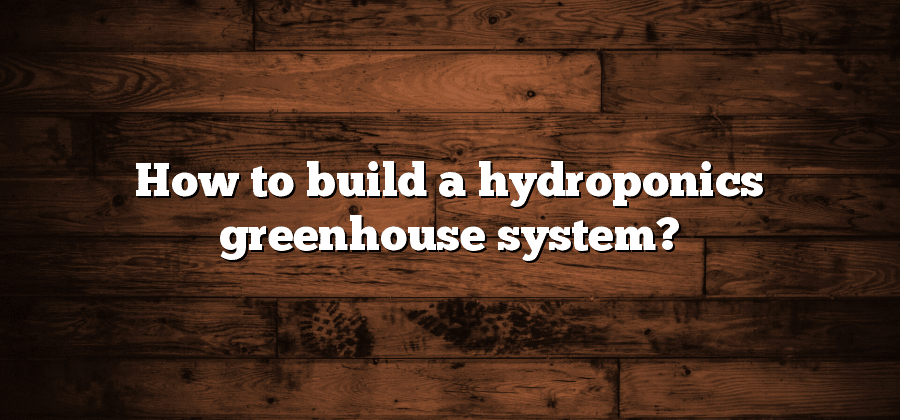Understanding the Basics of Hydroponics Greenhouse Systems
Hydroponics greenhouse systems have gained popularity in recent years. This method of gardening allows plants to grow without soil, using a nutrient-rich water solution instead. Understanding the basics of hydroponics greenhouse systems is essential for anyone interested in this innovative and efficient form of gardening.
One of the key components of a hydroponics greenhouse system is the water reservoir. This is where the nutrient solution is stored and circulated to the plants. It is important to monitor the pH levels and nutrient concentrations in the water to ensure optimal growth for the plants. Additionally, the water must be oxygenated to promote healthy root development. By understanding these basic principles, individuals can create a successful hydroponics greenhouse system that yields high-quality crops year-round.
Selecting the Right Location for Your Hydroponics Greenhouse
When it comes to selecting the right location for your hydroponics greenhouse, there are several factors to consider. The first and most important factor is sunlight. Your greenhouse should ideally be placed in a location that receives ample sunlight throughout the day. This is essential for the growth and development of your hydroponic plants. Additionally, it is crucial to choose a location that is sheltered from strong winds and extreme weather conditions. High winds can damage your greenhouse structure and disrupt the growing environment inside. Lastly, accessibility is another factor to take into account. You want to choose a location that is easily accessible for maintenance, harvesting, and transporting supplies to and from the greenhouse. By considering these factors, you can ensure the success of your hydroponics greenhouse by selecting the right location.
Choosing the Appropriate Structure and Design for Your Greenhouse
When it comes to choosing the structure and design for your hydroponics greenhouse, several factors should be taken into consideration. First and foremost, you need to assess your available space and determine the size of the greenhouse that best fits your needs. Consider the type and quantity of crops you plan to grow, as well as any additional equipment or systems you will be incorporating. This will ensure that you have enough space to accommodate your plants and provide an efficient working environment.
Another important aspect to consider is the materials used in constructing the greenhouse. Opt for materials that are durable, offer good insulation properties, and are resistant to harsh weather conditions. This will help to maintain a stable and controlled environment for your plants, enhancing their growth and productivity. Additionally, choose a design that allows for ample ventilation, as proper air circulation is crucial for preventing diseases and maintaining optimal temperature and humidity levels.
Overall, the structure and design of your hydroponics greenhouse play a vital role in the success of your crops. By carefully considering your space, crop requirements, and construction materials, you can create a greenhouse that not only provides a conducive environment for plant growth but also ensures long-term sustainability and productivity.
Selecting the Right Hydroponics System for Your Greenhouse
When it comes to selecting the right hydroponics system for your greenhouse, there are several factors to consider. First and foremost, you need to determine the size and scale of your operation. Are you looking to start small with a hobby greenhouse, or do you have plans to expand into a commercial venture? This will help you determine the type of hydroponics system that will best suit your needs.
Another important factor to consider is the type of plants you plan to grow. Different plants have different nutrient requirements, so it is crucial to choose a hydroponics system that can effectively deliver the necessary nutrients to your crops. Additionally, consider the space available in your greenhouse. Some hydroponics systems require more space than others, so make sure you have enough room to accommodate the system you choose.
In addition to these factors, you should also consider your level of experience with hydroponics. If you are new to hydroponics, you may want to start with a simpler system that is easier to manage and maintain. As you gain experience and confidence, you can always upgrade to a more advanced system.
Overall, selecting the right hydroponics system for your greenhouse is a crucial decision that will greatly impact your success in growing healthy and thriving plants. Take the time to research and consider all of the factors mentioned above to ensure you make the best choice for your specific needs and goals.
Creating an Efficient Water and Nutrient Management Plan
One of the most critical aspects of successful hydroponics greenhouse systems is the implementation of an efficient water and nutrient management plan. This plan ensures that plants receive the necessary nutrients and water in the right quantities and at the right times. A well-executed water and nutrient management plan can lead to optimal plant growth, increased productivity, and reduced wastage of resources.
When developing a water and nutrient management plan, it is essential to consider factors such as the type of hydroponic system being used, the specific requirements of the plants being cultivated, and the quality of the water source. Monitoring and maintaining the pH levels of the nutrient solution is crucial to avoid nutrient lockout and ensure that plants can absorb the necessary elements effectively. Additionally, regular monitoring of electrical conductivity (EC) levels helps ensure the nutrient solution’s proper concentration, promoting balanced plant nutrition. By carefully managing water usage, recycling it whenever possible, and preventing the accumulation of excess salts, growers can create a sustainable system that minimizes waste and environmental impact.






